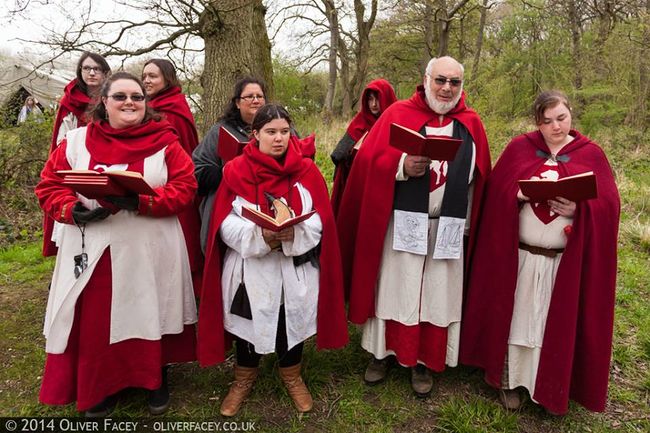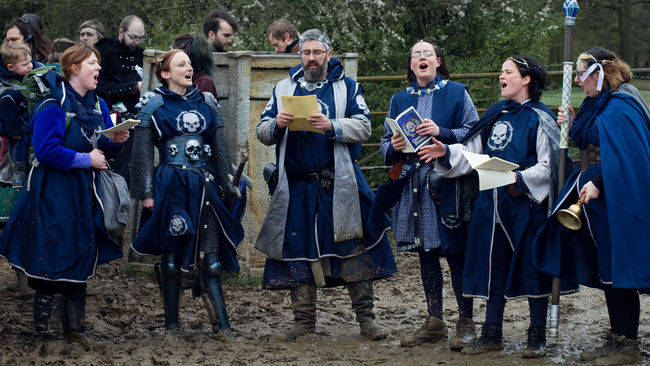Highguard music
mNo edit summary |
No edit summary |
||
| (8 intermediate revisions by 4 users not shown) | |||
| Line 1: | Line 1: | ||
{{CaptionedImage|file=HighbornMusic.jpg|width=650|align=right|caption=Choristers of Cantiarch's Hold | {{CaptionedImage|file=HighbornMusic.jpg|width=650|align=right|caption=Choristers of Cantiarch's Hold.}} | ||
==The Music of Highguard== | ==The Music of Highguard== | ||
===Style summary=== | ===Style summary=== | ||
| Line 10: | Line 10: | ||
Popular with all strata of Highguard society, these three songs are heard in chapters, the necropolis, and the fields. It is when the army marches to war with its battle choir, however, that the full majesty of Highguard music is best displayed. | Popular with all strata of Highguard society, these three songs are heard in chapters, the necropolis, and the fields. It is when the army marches to war with its battle choir, however, that the full majesty of Highguard music is best displayed. | ||
{{CaptionedImage|file=Silver Skull Music.jpg|width=650|align=right|caption=Highguard's music is robust and enthusiastic, accessible to all levels of talent.}} | |||
====A musical tradition==== | ====A musical tradition==== | ||
The Highguard Battle Choirs are a great imperial tradition - no nation | The Highguard Battle Choirs are a great imperial tradition - no nation marches to battle with the same holy fervour in their singing. Usually accompanied by a single drumbeat, the sound of the Highguard army in full voice is an awe-inspiring and intimidating sound. Often a small number of more confident singers lead the chant in a call-and-response pattern. At least in this context the choirsters are warriors first and musicians second - the singers need not be particularly talented, as it is holy fervour and their indomitable will that characterises the battle choir. | ||
====One for the kids==== | ====One for the kids==== | ||
*[[Circle March]] - very easy repeating song | *[[Circle March]] - very easy repeating song | ||
====Songs about notable people and entities in Highguard==== | ====Songs about notable people and entities in Highguard==== | ||
| Line 28: | Line 27: | ||
====Songs==== | ====Songs==== | ||
* [[For Once I Was A Young Man]] -cautionary tale about the virtuous life | * [[For Once I Was A Young Man]] - cautionary tale about the virtuous life | ||
* [[The Ritual for the Departed]] - haunting funerary song | * [[The Ritual for the Departed]] - haunting funerary song | ||
* [[Gone]] - another song for partings and funerals | * [[Gone]] - another song for partings and funerals | ||
| Line 36: | Line 35: | ||
* [[Hymn to Vigilance]] - medium call and response plainsong | * [[Hymn to Vigilance]] - medium call and response plainsong | ||
* [[Idumea]] - medium shapenote song about reincarnation | * [[Idumea]] - medium shapenote song about reincarnation | ||
* [[O Oriens]] - easy plainsong | * [[O Oriens]] - easy plainsong | ||
* [[Virtue Never Falter]] - rousing song with chorus, also popular in the Brass Coast | * [[Virtue Never Falter]] - rousing song with chorus, also popular in the Brass Coast | ||
| Line 43: | Line 41: | ||
* [[Highguard Go To War]] - Battle anthem | * [[Highguard Go To War]] - Battle anthem | ||
* [[All Come Listen]] - a well known, simple song that can be sung as a round | * [[All Come Listen]] - a well known, simple song that can be sung as a round | ||
* [[The Waystone Anthem]] - a song celebrating Virtue and The Way | |||
* [[The Solace of Bells]] - a choral piece of remembrance; written for the Day of the Dead | |||
====Instrumentation==== | ====Instrumentation==== | ||
| Line 59: | Line 59: | ||
Here is a [https://www.youtube.com/watch?v=hOagOv6ztZg&list=PL58F0C16B0DEB67D1&feature=plpp_play_all youtube playlist] of appropriate or inspiring music. | Here is a [https://www.youtube.com/watch?v=hOagOv6ztZg&list=PL58F0C16B0DEB67D1&feature=plpp_play_all youtube playlist] of appropriate or inspiring music. | ||
[[Category:Music]] | |||
[[Category:Highguard Music]] | [[Category:Highguard Music]] | ||
{{Highguard Links}} | |||
Latest revision as of 12:32, 23 January 2025
The Music of Highguard
Style summary
Highguard's music draws its inspiration from Western church choral music, plainsong and shapenote music (also known as Sacred Harp). Of these, the last probably best exemplifies the musical style - Highguard music is robust and enthusiastic, and accessible to all levels of talent. They enjoy rich harmonies and proudly devotional texts, although amongst themselves a wicked sense of humour occasionally emerges in some soldiers' songs and there are also some surprisingly tender lullabies.
Commonly known songs
- Virtues Anthem - usually led by one singer with everyone joining in the refrain
- Circle March - very easy repeating song
- Hymn to Vigilance - usually led by one singer with everyone joining in the refrain
Popular with all strata of Highguard society, these three songs are heard in chapters, the necropolis, and the fields. It is when the army marches to war with its battle choir, however, that the full majesty of Highguard music is best displayed.
A musical tradition
The Highguard Battle Choirs are a great imperial tradition - no nation marches to battle with the same holy fervour in their singing. Usually accompanied by a single drumbeat, the sound of the Highguard army in full voice is an awe-inspiring and intimidating sound. Often a small number of more confident singers lead the chant in a call-and-response pattern. At least in this context the choirsters are warriors first and musicians second - the singers need not be particularly talented, as it is holy fervour and their indomitable will that characterises the battle choir.
One for the kids
- Circle March - very easy repeating song
Songs about notable people and entities in Highguard
- Enoch and Levi - romantic ballad, Highguard style...
- Pride of the Highborn - anthem of Adina's Charge
- Silent Tide- anthem of the Chapter of the same name.
- Anthem of Cantiarch's Hold
- Vigilance Guide Our Faithful Watch -A song commemorating the founder of Felix's Watch.
Further examples
Songs
- For Once I Was A Young Man - cautionary tale about the virtuous life
- The Ritual for the Departed - haunting funerary song
- Gone - another song for partings and funerals
- Virtues Anthem - shapenote song with chorus
- The Navigators - shapenote song, medium
- Circle March - very easy repeating song
- Hymn to Vigilance - medium call and response plainsong
- Idumea - medium shapenote song about reincarnation
- O Oriens - easy plainsong
- Virtue Never Falter - rousing song with chorus, also popular in the Brass Coast
- Least of my Kind - stirring battle song
- Farewell Farewell - rousing funeral song from Highguard but also popular in the Brass Coast due to boat references
- Highguard Go To War - Battle anthem
- All Come Listen - a well known, simple song that can be sung as a round
- The Waystone Anthem - a song celebrating Virtue and The Way
- The Solace of Bells - a choral piece of remembrance; written for the Day of the Dead
Instrumentation
- Highborn musical traditions favour the flute and other wind instruments. On days when the wind is high, a chapterhouse resounds with the song of wind chimes, aeolian harps and bells.
- Trumpets and bugles are often blown before a battlefield charge.
Other performance traditions
How to adapt your repertoire
- If singing in harmony, try to sing in consecutive 4ths or 5ths. This gives a fantastic 'plainchanty' sound perfect for Highguard. An example is Circle March (arranged by Katy Cooper) which starts in unison then goes into 4ths before full harmony.
- Many songs can be made to sound plainchanty by just pulling the rhythm all over the place. Have a listen to some church psalms and simply substitute your own lyrics.
Our sources
Shape note/Sacred Harp singings (Northern or Southern Harmony), any plainchant choir,
Here is a youtube playlist of appropriate or inspiring music.
Further Reading
Core Brief
Additional Information

